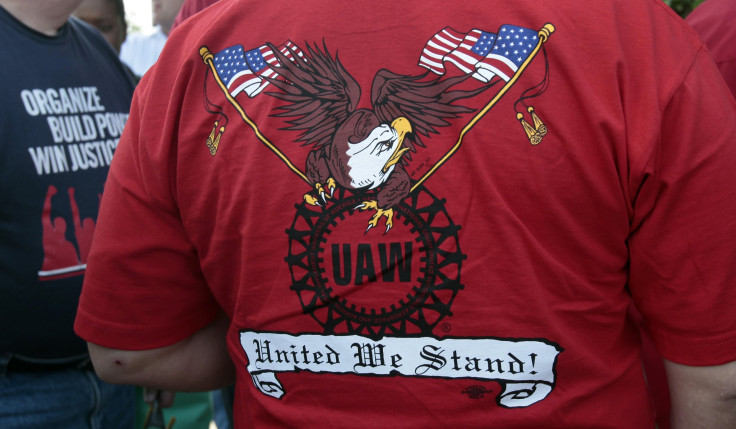United Auto Workers Contract Talks: Automakers Will Fight To Keep ‘Second Tier’ Workers Who Earn Less For Same Work

Five-plus years after the U.S. economy began to slowly rebound, the Detroit Three automakers are profitable again, selling almost as many cars in 2014 as in 2005. Meanwhile, most of their hourly workers haven’t seen a base-wage hike in a decade.
During the Great Recession that sent the corporate predecessors of General Motors Co. and the FCA US LLC (Chrysler) unit of Fiat Chrysler Automobiles NV into bankruptcy, tens of thousands of unionized hourly workers gave significant concessions to U.S. automakers in an effort to save their jobs.
As the United Auto Workers prepares to negotiate new four-year agreements with General Motors, FCA and Ford Motor Co., the Detroit Three can no longer blame recession-related woes for their resistance to workers’ demands. Instead, they’re preparing to argue a general need to keep labor costs in line to remain competitive on their home turf. Rivals such as Honda Motor Co. Ltd. and the Toyota Motor Corp. have kept wages lower than their Michigan competitors through nonunion factories in the southern U.S.
Before the talks beginning in July, UAW delegates ended a two-day Special Convention on Collective Bargaining Wednesday. The union stopped short of calling for a scrapping of a controversial pay arrangement known as the two-tier wage system, which has hourly employees hired at Detroit Three plants after 2008 earning less than workers hired before then -- even when doing the same work.
“The UAW is finding out that it’s much easier to get into a two-tier wage system than to get out of it,” said Gary Chaison, professor of industrial relations at Clark University. “The automakers have an embarrassment of riches right now, so they’ll have to make a case that they’re doing better, but that their conditions are still fragile.”
In a speech at Detroit’s Cobo Center Wednesday, UAW President Dennis Williams railed against an economic recovery that hasn’t delivered wage growth for many working Americans.
“As we share in the bad times, we must equally share in the good times,” Williams said, alluding to the concessions his union made during 2007 contract talks, which included giving up the right to authorize a strike at GM or Chrysler, a provision expiring this year.
Automakers certainly cannot argue they’re still operating in the bad times of the last recession.
U.S. new-auto sales have grown at a record pace for much of the past five years. And, in 2015, new-car deliveries are expected to hit or top 17 million for the first time in more than a decade. General Motors reported $4.31 billion in profit last year. It has been making so much money because of the demand for its high-profit-margin SUVs and trucks that this month it quickly agreed to a $5 billion stock buyback, bowing to activist hedge-fund investors’ demands.
But the Detroit Three automakers argue the two-tier wage system is still necessary.
“The entry-level agreement has enabled Ford to insource work, grow jobs and invest in the U.S.,” Kristina Adamski, a head of manufacturing communications at Ford, said via email. “For the 2015 negotiations, we’re open to discussing many different solutions with our UAW partners that will allow us to continue to employ a competitive labor rate and add U.S. jobs and investment.”
General Motors and Ford bear some of the highest labor costs per worker among the largest automakers with factories in the U.S., according to the latest wage analysis by the Center for Automotive Research. Last year, GM paid $58 per worker per hour (including profit-sharing bonuses and benefits), while Ford paid $57. Chrysler paid $48. Meanwhile, most foreign rivals, which run nonunion factories in the U.S., spent considerably less. One reason for the disparity centers on the fact that the U.S. units of companies such as Honda and Toyota have lower so-called legacy costs, mostly related to retirement benefits.
With all the positive news on the automotive front, many of the UAW’s rank-and-file members have demanded that eliminating the two-tier wage system should be a top priority.
Under the system, autoworkers who landed jobs with U.S. automakers since 2008 earn significantly less than those hired before then. During the 2011 contract negotiations, the UAW eked out a pay hike for the second-tier employees, giving them starting wages of $15.78 an hour, which increased to $19.28 after four years. The average hourly wage for workers hired before 2008 is $28, according to the union.
About 28 percent of the roughly 137,000 Detroit Three hourly employees spread out in factories across several states earn second-tier wages, which UAW members say has created a two-class wage system among them that threatens the sense of solidarity the union is supposed to engender.
Auto companies prefer to grant profit-sharing bonuses over raises because the bonuses aren’t fixed expenses and can be adjusted based on the companies’ ongoing performances. GM paid as much as $8,800 in profit-sharing bonuses to its more than 48,000 hourly workers in 2014, up from the maximum of $7,500 the previous year. Ford paid as much as $6,900 to its nearly 50,000 hourly workers last year. And Chrysler paid as much as $2,750 to its roughly 37,500 employees during the same period.
But the UAW is attempting to secure increases in base pay, because the base is more reliable, even though the resultant higher labor costs could cut the profit-sharing bonuses. Meanwhile, the union appears to be backing off efforts to eliminate the two-tier wage system, as it instead seeks to close the gap between the two tiers by calling for another pay hike for second-tier employees. Senior workers, who have seen two contracts come and go without increases, will also want raises. So, while all Detroit Three workers could get pay boosts after September, the temporary two-tier wage system is starting to look more like a permanent system -- or, at least, an indefinite one.
© Copyright IBTimes 2025. All rights reserved.






















